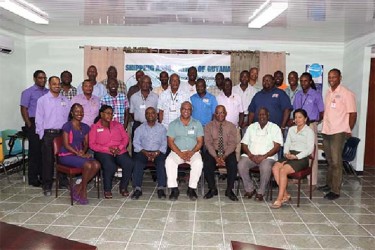Extensive capital dredging of the harbour facility at Port Georgetown to enable access for larger vessels remains a critical issue on the local maritime agenda, Executive Secretary of the Shipping Association of Guyana Ian D’Anjou said.
According to the Shipping Association official, undertaking improvements to local port facilities in Georgetown is also linked to the country providing a positive response to known Brazilian interest in utilizing those facilities as an outlet for its goods seeking access to the Caribbean and beyond. He said the Shipping Association had been in the process of having a delegation visit Brazil to discuss the issue of the transshipment of goods, but the actualization of such a venture would hinge on both the improvement of local port facilities

and the completion of a usable Lethem-Georgetown road.
Meanwhile, according to D’Anjou, the association was otherwise intimately involved in supporting its members in pursuit of upgrading port facilities in Georgetown.
Public/private sector discourse on the dredging of the harbour has been ongoing for several years and while D’Anjou confirmed that the Maritime Administration Department (MARAD) dredge Steve N has been doing some work, he said what was needed was a thorough “capital dredging” exercise that included “properly clearing the channel, removing hard rock as well as removing debris from wreckage.”
D’Anjou said that while the Shipping Association was aware that there had been a $100 million allocation in this year’s national budget for “port development” the entity had heard nothing more about how the allocation was to be used. He said that over time the association had sought the support of the private sector in seeking to have port development placed more prominently on the front burner of the national agenda.
The strongest argument that has been made for the significant upgrading of local port facilities over the years has had to do with the impact of the inability of berthing large cargo vessels in Port Georgetown, including the necessity of transshipment of cargo from other ports in the region including Kingston and Port of Spain which makes shipping rates to Guyana among the most expensive in the Caribbean. D’Anjou told Stabroek Business that the need to effect key improvements to Port Georgetown were also linked, critically, to increasing the volume of the country’s exports.
The Shipping Association, meanwhile, according to D’Anjou, has been working with its members and in collaboration with the International Maritime Organization (IMO) to enhance capacity in the sector. Earlier this month the association hosted a one-day seminar on the International Maritime Dangerous Goods (IMDG) Code, which D’Anjou said included a range of goods that were so categorized either because they might endanger the safety of the crew and vessel or because they might pose a threat to the environment in the event of a spill or accident. He said training and sensitization for entities in the sector was being undertaken in an effort to ensure compliance with the International Convention for the Safety of Life at Sea and the International Convention for the Prevention of Pollution From Ships.
The nine different classes of dangerous cargo are explosives, compressed, liquefied or dissolved gases, flammable liquids, flammable solids, oxidizers, toxic and infectious substances, radioactive materials and corrosives and marine pollutants that may not meet the definition of dangerous goods but might be classified as environmentally hazardous substances.
Participants at the seminar included employees of 13 shipping-related entities including John Fernandes Ltd, Laparkan Trading, Muneshwer’s Ltd, and D&J Shipping.
Last year, the volume of containerized cargo moving in and out of Guyana amounted to the equivalent of 72,000 20-foot containers, an amount that exceeded the 2013 figure by 8 per cent. These volumes, according to D’Anjou, were modest, compared with the larger territories in the region.
And according to D’Anjou port authorities were now coming under more scrupulous international attention to comply with port security codes. He said that arising out of a visit here by the United States Coastguard on behalf of the International Maritime Organization some terminals were found to be not up to the minimum standards required under the international maritime regime.









